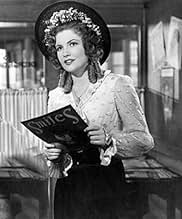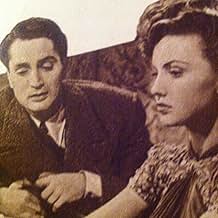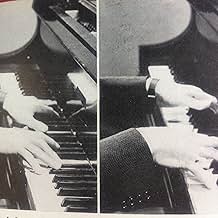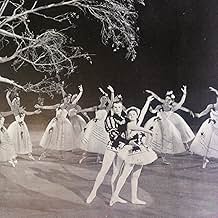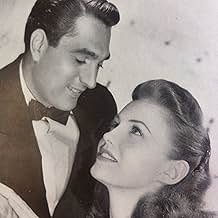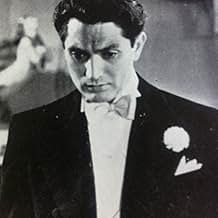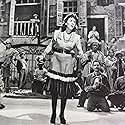AVALIAÇÃO DA IMDb
7,0/10
1,9 mil
SUA AVALIAÇÃO
Adicionar um enredo no seu idiomaGeorge Gershwin is a driven composer whose need to succeed destroys his relationship with singer Julie Adams and socialite Christine Gilbert.George Gershwin is a driven composer whose need to succeed destroys his relationship with singer Julie Adams and socialite Christine Gilbert.George Gershwin is a driven composer whose need to succeed destroys his relationship with singer Julie Adams and socialite Christine Gilbert.
- Direção
- Roteiristas
- Artistas
- Indicado a 2 Oscars
- 2 vitórias e 4 indicações no total
Albert Bassermann
- Prof. Franck
- (as Albert Basserman)
Rosemary DeCamp
- Rose Gershwin
- (as Rosemary De Camp)
Avaliações em destaque
RHAPSODY IN BLUE (Warner Brothers, 1945), directed by Irving Rapper, subtitled "The Story of George Gershwin," is a tribute to America's most original composer of the twentieth century. It's an entertaining musical biography if one could overlook its faults. Made at the time when movies of this type dominated the screen, beginning with YANKEE DOODLE DANDY (1942) with James Cagney as actor and songwriter George M. Cohan, Warners later contributed another using a song title to personify the subject matter, Cole Porter in NIGHT AND DAY (1946) as portrayed by Cary Grant. Obviously YANKEE DOODLE DANDY is the best of the three, however, while NIGHT AND DAY offers an added plus with Technicolor, it makes RHAPSODY IN BLUE better than what it is. Unlike the two mentioned bio-pics, RHAPSODY IN BLUE is not headlined by a major name, but a newcomer named Robert Alda, who, unlike Cagney and Grant, never became a top rank star. One thing going for Alda is his resemblance to George Gershwin, and how acceptable he is in what has become his best known film role. Unfortunately, that's where the Gershwin legend ends. Hoping for another YANKEE DOODLE DANDY, Warners reused its co-stars, Joan Leslie as the fictitious girlfriend, and Rosemary DeCamp as the mother, the sort of roles they've done before. The result: the music that outscores an episodic story.
The story of George Gershwin, according to an original story by Sonya Levien, opens on the lower East side of Manhattan with brothers George and Ira Gershwin as boys (Darryl Hickman and Mickey Roth) watching men delivering a piano to their apartment. The piano was ordered for Ira to take lessons, but their mother, Rose (Rosemary DeCamp) can't help but notice George's natural talent for the piano without a single lesson. Years pass, the now adult George (Robert Alda), develops a new method in piano playing, lands a job playing songs for customers, getting himself fired for going against management by demonstrating his own songs. In time, he gets his big break when publisher Max Dreyfus (Charles Coburn) introduces Gershwin's latest composition, "Swanee," to Broadway entertainer Al Jolson, who likes the song so much that he introduces it in his next Broadway show, SINBAD. Jolson's delivery to "Swanee" elevates Gershwin into an exceptional and most original composer. Collaborating his songs with Ira (Herbert Rudley), Broadway shows featuring one hit song after another, along with George's on and off romances with Julie Adams (Joan Leslie), a singer who loves him, and Christine Gilbert (Alexis Smith), a socialite/ divorcée who knows she'll be nothing more than a backdrop to his life. In spite of fame and fortune, especially with his masterpiece, "Rhapsody in Blue," George is not a happy man, and strives to improve himself, doing everything in such quick pace as if he has some premonition of an untimely death.
The supporting players feature Julie Bishop as Lee Gershwin; Albert Basserman as Professor Frank; Morris Conovsky as Morris Gershwin; Johnny Downs as a tap-dancer; with Paul Whiteman, George White, Tom Patricola, Hazel Scott guest starring as themselves. A pity that Fred Astaire, whose best known for introducing some classic Gershwin tunes, didn't appear. The highlight of the program is Al Jolson singing "Swanee." This became Jolson's final contribution to the motion picture by which he takes part in the plot, but this would not be the last time his voice would be heard on screen. Jolson appears in two key scenes, each in his black-face trademark, first from his dressing room on the telephone and later on opening night. While age has caught up with Jolson physically, his delivery to "Swanee" proves he still has that old magic. A pity he didn't contribute more to the story. Oscar Levant, playing his usual droll self, provides some amusing moments as Gershwin's close friend, as well as his piano solos.
Of the many songs composed by George Gershwin, the ones selected for the soundtrack include: "Smiles," (not by Gershwin); "Swanee," "S' Wonderful, S' Marvelous," "Somebody Loves Me," "I'll Build a Stairway to Paradise," "Lady Be Good," "Blue Monday Blues" followed by "My Joe" and "Mother Mine," "Rhapsody in Blue" (conducted by Paul Whiteman); Braham's "Lullaby" (background score); Hazel Scott's piano playing and vocalization of "The Man I Love" (in French); "Clap Yo Hands," "Fascinatin' Rhythm," "I Got Rhythm" and "Yankee Doodle Blues"; "Liza," "Bidin' My Time," "Embraceable You," "An American in Paris" (instrumental); "Cuban Rhapsody," "Our Love is Here to Stay," "Delicious," "Summertime" from PORGY AND BESS; "Concerto in F", "135th Street Blues," "Love Walked In," "Concerto in F" (reprise); and "Rhapsody in Blue"(reprise/finale).
Not historically accurate as one would like it to be, although the costumes and hair styles do fit into the time frames, RHAPSODY IN BLUE should be a delight for Gershwin fans, considering how it concentrates more on his songs than on his personal life. Running more than two hours, the narrative includes several scenes that drag on, but as long as there's enough Gershwin music to fill in the void, it shouldn't appear endless.
RHAPSODY IN BLUE, may not be the success in the tradition of YANKEE DOODLE DANDY nor Robert Alda as legendary as James Cagney, but George Gershwin's contribution to American music, jazz, blues and/or folk opera, remains legendary. RHAPSODY IN BLUE formerly available on video cassette, is shown on Turner Classic Movies. Running time: 142 minutes - "a very important piece." (***1/2)
The story of George Gershwin, according to an original story by Sonya Levien, opens on the lower East side of Manhattan with brothers George and Ira Gershwin as boys (Darryl Hickman and Mickey Roth) watching men delivering a piano to their apartment. The piano was ordered for Ira to take lessons, but their mother, Rose (Rosemary DeCamp) can't help but notice George's natural talent for the piano without a single lesson. Years pass, the now adult George (Robert Alda), develops a new method in piano playing, lands a job playing songs for customers, getting himself fired for going against management by demonstrating his own songs. In time, he gets his big break when publisher Max Dreyfus (Charles Coburn) introduces Gershwin's latest composition, "Swanee," to Broadway entertainer Al Jolson, who likes the song so much that he introduces it in his next Broadway show, SINBAD. Jolson's delivery to "Swanee" elevates Gershwin into an exceptional and most original composer. Collaborating his songs with Ira (Herbert Rudley), Broadway shows featuring one hit song after another, along with George's on and off romances with Julie Adams (Joan Leslie), a singer who loves him, and Christine Gilbert (Alexis Smith), a socialite/ divorcée who knows she'll be nothing more than a backdrop to his life. In spite of fame and fortune, especially with his masterpiece, "Rhapsody in Blue," George is not a happy man, and strives to improve himself, doing everything in such quick pace as if he has some premonition of an untimely death.
The supporting players feature Julie Bishop as Lee Gershwin; Albert Basserman as Professor Frank; Morris Conovsky as Morris Gershwin; Johnny Downs as a tap-dancer; with Paul Whiteman, George White, Tom Patricola, Hazel Scott guest starring as themselves. A pity that Fred Astaire, whose best known for introducing some classic Gershwin tunes, didn't appear. The highlight of the program is Al Jolson singing "Swanee." This became Jolson's final contribution to the motion picture by which he takes part in the plot, but this would not be the last time his voice would be heard on screen. Jolson appears in two key scenes, each in his black-face trademark, first from his dressing room on the telephone and later on opening night. While age has caught up with Jolson physically, his delivery to "Swanee" proves he still has that old magic. A pity he didn't contribute more to the story. Oscar Levant, playing his usual droll self, provides some amusing moments as Gershwin's close friend, as well as his piano solos.
Of the many songs composed by George Gershwin, the ones selected for the soundtrack include: "Smiles," (not by Gershwin); "Swanee," "S' Wonderful, S' Marvelous," "Somebody Loves Me," "I'll Build a Stairway to Paradise," "Lady Be Good," "Blue Monday Blues" followed by "My Joe" and "Mother Mine," "Rhapsody in Blue" (conducted by Paul Whiteman); Braham's "Lullaby" (background score); Hazel Scott's piano playing and vocalization of "The Man I Love" (in French); "Clap Yo Hands," "Fascinatin' Rhythm," "I Got Rhythm" and "Yankee Doodle Blues"; "Liza," "Bidin' My Time," "Embraceable You," "An American in Paris" (instrumental); "Cuban Rhapsody," "Our Love is Here to Stay," "Delicious," "Summertime" from PORGY AND BESS; "Concerto in F", "135th Street Blues," "Love Walked In," "Concerto in F" (reprise); and "Rhapsody in Blue"(reprise/finale).
Not historically accurate as one would like it to be, although the costumes and hair styles do fit into the time frames, RHAPSODY IN BLUE should be a delight for Gershwin fans, considering how it concentrates more on his songs than on his personal life. Running more than two hours, the narrative includes several scenes that drag on, but as long as there's enough Gershwin music to fill in the void, it shouldn't appear endless.
RHAPSODY IN BLUE, may not be the success in the tradition of YANKEE DOODLE DANDY nor Robert Alda as legendary as James Cagney, but George Gershwin's contribution to American music, jazz, blues and/or folk opera, remains legendary. RHAPSODY IN BLUE formerly available on video cassette, is shown on Turner Classic Movies. Running time: 142 minutes - "a very important piece." (***1/2)
This film presents many Gershwin tunes in great fashion with several great settings and great production numbers. Yes, it's unfortunate that the story line is so heavily fictionalized and even misleading. But, the sets are honest to the periods covered, several sequences are very tastefully done and fun, the show excerpts are good, and did I mention the music? As several other commentators have indicated, the music is faithfully recreated in long segments that bring you much or all of the tune.
If you come to this film to hear some wonderful Gershwin performed by some great artists staged with a lot of character and splash (my favorite set is Hazel Scott's Paris show), you won't be disappointed. The story line is simply a convenient string to tie together the thread of music.
If you come to this film to hear some wonderful Gershwin performed by some great artists staged with a lot of character and splash (my favorite set is Hazel Scott's Paris show), you won't be disappointed. The story line is simply a convenient string to tie together the thread of music.
This is a fabulous movie tracing the life and times, struggles and successes of composer George Gershwin. Fictional characters and events are used to move the story along; and the music is wonderful. This is a very easy to watch movie. A classic in black & white.
Beginning with childhood, this movie shows the closeness of the family and especially with brother Ira. Major compositions are featured: Swanee; The Cuban Overture; Somebody Loves Me; Fascinatin' Rhythm; An American in Paris and several versions of the title masterpiece, Rhapsody in Blue. Max Steiner proves his own greatness.
Robert Alda is excellent as George Gershwin and Herbert Rudley as Ira. Also in the cast are Rosemary DeCamp, Alexis Smith and Joan Leslie. Playing themselves are Paul Whiteman, Oscar Levant and Al Jolson. Levant is refreshing, comical and talented.
The music is the main attraction; this film is well worth multiple viewings.
Beginning with childhood, this movie shows the closeness of the family and especially with brother Ira. Major compositions are featured: Swanee; The Cuban Overture; Somebody Loves Me; Fascinatin' Rhythm; An American in Paris and several versions of the title masterpiece, Rhapsody in Blue. Max Steiner proves his own greatness.
Robert Alda is excellent as George Gershwin and Herbert Rudley as Ira. Also in the cast are Rosemary DeCamp, Alexis Smith and Joan Leslie. Playing themselves are Paul Whiteman, Oscar Levant and Al Jolson. Levant is refreshing, comical and talented.
The music is the main attraction; this film is well worth multiple viewings.
George Gershwin was perhaps, America's greatest composer. Judging by his output of popular songs, as well as some of the serious music he left behind. George Gershwin was a man that got his inspiration by a lot of the popular and black music he heard when he was growing up and mixed it with some of the classical music that he learned as a young piano student. The result is a body of work that is not easy equaled by any of his contemporaries.
In "Rhapsody in Blue", his biographical picture, director Irving Rapper has recreated that period in the young composer's life with the help of the screen play writers, Howard Koch, Sonya Levien, and the uncredited Clifford Odets, as he takes us along to witness a account on this original music man.
We get to see the ambitious George, who could play anything on the piano his parents intended for his brother Ira to study music. It was clear from the start George was a natural who had no problem composing some of the best melodies that became standards during the 20th century and continue to delight us after so many years.
Along the way there is the story of the man who falls in love with the lovely and sophisticated Christine Gilbert, who he met in France. Julie Adams, the girl who was to become the star in many of his shows, loved George in silence. Of course, these two women are a product of the writers imagination, or a composite for the real women in his life.
We are also shown the world in which George lived. There is Prof. Frank, who taught the young man the best of the classical piano repertoire. His parents, Morris and Rose, who adored their sons. We also meet some of the men that shaped his life like Max Dreyfus, his manager, Oscar Levant, his friend and best interpreter, along with some real figures like Paul Whiteman, George White, Al Jolson, Hazel Scott, among others.
Robert Alda resembled the real George Gershwin; his take on the man rings true. Joan Leslie is Julie Adams, and Alexis Smith is Christine Gilbert, the women in George life. Charles Coburn plays Max Dreyfus. Morris Carnovsky and Rosemary DeCamp are seen as the parents.
The best excuse to watch the film is the glorious music one hears in it. The movie is easy on the eye, and while it might not be accurate, it still makes for a pleasant view of this genius of some of the best American popular music of all times.
In "Rhapsody in Blue", his biographical picture, director Irving Rapper has recreated that period in the young composer's life with the help of the screen play writers, Howard Koch, Sonya Levien, and the uncredited Clifford Odets, as he takes us along to witness a account on this original music man.
We get to see the ambitious George, who could play anything on the piano his parents intended for his brother Ira to study music. It was clear from the start George was a natural who had no problem composing some of the best melodies that became standards during the 20th century and continue to delight us after so many years.
Along the way there is the story of the man who falls in love with the lovely and sophisticated Christine Gilbert, who he met in France. Julie Adams, the girl who was to become the star in many of his shows, loved George in silence. Of course, these two women are a product of the writers imagination, or a composite for the real women in his life.
We are also shown the world in which George lived. There is Prof. Frank, who taught the young man the best of the classical piano repertoire. His parents, Morris and Rose, who adored their sons. We also meet some of the men that shaped his life like Max Dreyfus, his manager, Oscar Levant, his friend and best interpreter, along with some real figures like Paul Whiteman, George White, Al Jolson, Hazel Scott, among others.
Robert Alda resembled the real George Gershwin; his take on the man rings true. Joan Leslie is Julie Adams, and Alexis Smith is Christine Gilbert, the women in George life. Charles Coburn plays Max Dreyfus. Morris Carnovsky and Rosemary DeCamp are seen as the parents.
The best excuse to watch the film is the glorious music one hears in it. The movie is easy on the eye, and while it might not be accurate, it still makes for a pleasant view of this genius of some of the best American popular music of all times.
Of all our famous Tin Pan Alley composers George Gershwin alone managed to bridge that gap between the old masters of Europe and our own American musical traditions. I've always had a particular affinity for his music, maybe because he and I share the same birthday, 49 years apart though. He did so much in his life of 38 years and left so much unwritten and unsung it's impossible to comprehend all this beauty could have come from the mind of one man.
Rhapsody In Blue is no better or worse than some of the other Hollywood biographies of our composers. The idea was to make a musical picture and story is always sacrificed, especially in the accuracy department. Joan Leslie and Alexis Smith play a compilation of characters of many women involved in George Gershwin's life. It is true however that Gershwin sacrificed all for his art. He wanted to attain heights that no American composer ever did and he succeeded.
There is also the problem of contracts and copyrights in making these kind of films. Certain Gershwin standards you won't hear because either Warner Brothers didn't have the rights or Jack Warner was spending way too much money for the Gershwin songs to begin with.
Al Jolson, Paul Whiteman, and Oscar Levant all appear as themselves in this, the story of Gershwin could not be told without them. Jolson introduced Gershwin's first hit song of Swanee, he interpolated it in one of his shows which he always did. Paul Whiteman, the King of Jazz, took that crown with his concert at Aeolian Hall of Rhapsody In Blue from whence this film gets its title. It maybe the most well known instrumental piece of music by an American composer ever.
And certainly no life of Gershwin could have even been filmed without Oscar Levant whose friendship and abiding affection for George Gershwin was well known. Levant's wit was devastating, even upon himself and his friend George. But he worshiped at the altar of that music.
But a real treat for me was Anne Brown, the original Bess from Porgy and Bess singing Summertime. That alone is worth seeing this film.
Hazel Scott, singer, jazz pianist, and outspoken civil rights advocate plays a Josephine Baker type role and does several Gershwin numbers while he's in Paris. The film sadly makes no mention of Fred Astaire or Gertrude Lawrence both of whom are very important in George Gershwin's career. And it would have been nice to see Victor Moore playing Throttlebottom from Of Thee I Sing which got a one line mention about it winning a Pulitzer Prize and that was it.
Robert Alda plays the title role and he did get good reviews and to the limited extent the script gave the character, he does capture the essence of the driven Gershwin. Stardom in Hollywood would elude Alda however, he'd have to wait for Broadway and Guys And Dolls.
I was sorry to see the role of Ira Gershwin by Herbert Rudley given such a short shrift. Ira was an interesting man in his own right. He wrote lyrics with several other name composers both before and after his brother's demise. In fact he wrote with others specifically to establish his own credentials so no one would think he was just riding on brother George's coattails.
Gershwin's one man who could use a new biographical film. Maybe we can get a better idea of his life, have his songs done in proper chronological order and see him from another century's perspective.
Until then Rhapsody In Blue will give you a general idea.
Rhapsody In Blue is no better or worse than some of the other Hollywood biographies of our composers. The idea was to make a musical picture and story is always sacrificed, especially in the accuracy department. Joan Leslie and Alexis Smith play a compilation of characters of many women involved in George Gershwin's life. It is true however that Gershwin sacrificed all for his art. He wanted to attain heights that no American composer ever did and he succeeded.
There is also the problem of contracts and copyrights in making these kind of films. Certain Gershwin standards you won't hear because either Warner Brothers didn't have the rights or Jack Warner was spending way too much money for the Gershwin songs to begin with.
Al Jolson, Paul Whiteman, and Oscar Levant all appear as themselves in this, the story of Gershwin could not be told without them. Jolson introduced Gershwin's first hit song of Swanee, he interpolated it in one of his shows which he always did. Paul Whiteman, the King of Jazz, took that crown with his concert at Aeolian Hall of Rhapsody In Blue from whence this film gets its title. It maybe the most well known instrumental piece of music by an American composer ever.
And certainly no life of Gershwin could have even been filmed without Oscar Levant whose friendship and abiding affection for George Gershwin was well known. Levant's wit was devastating, even upon himself and his friend George. But he worshiped at the altar of that music.
But a real treat for me was Anne Brown, the original Bess from Porgy and Bess singing Summertime. That alone is worth seeing this film.
Hazel Scott, singer, jazz pianist, and outspoken civil rights advocate plays a Josephine Baker type role and does several Gershwin numbers while he's in Paris. The film sadly makes no mention of Fred Astaire or Gertrude Lawrence both of whom are very important in George Gershwin's career. And it would have been nice to see Victor Moore playing Throttlebottom from Of Thee I Sing which got a one line mention about it winning a Pulitzer Prize and that was it.
Robert Alda plays the title role and he did get good reviews and to the limited extent the script gave the character, he does capture the essence of the driven Gershwin. Stardom in Hollywood would elude Alda however, he'd have to wait for Broadway and Guys And Dolls.
I was sorry to see the role of Ira Gershwin by Herbert Rudley given such a short shrift. Ira was an interesting man in his own right. He wrote lyrics with several other name composers both before and after his brother's demise. In fact he wrote with others specifically to establish his own credentials so no one would think he was just riding on brother George's coattails.
Gershwin's one man who could use a new biographical film. Maybe we can get a better idea of his life, have his songs done in proper chronological order and see him from another century's perspective.
Until then Rhapsody In Blue will give you a general idea.
Você sabia?
- CuriosidadesChico Marx sued Warner Bros for $200,000 for damages and "payment owed for services rendered." Marx alleged that the filmmakers used his name many times in the film. Studio officials admitted that Marx's name had been used in the film, but were unclear about what services the comedian had rendered. The parties settled for $10,000.
- Erros de gravaçãoChico Marx is referred to early in the film. Gershwin mispronounces the name as "CHEE-ko", which generally continues to this day. Chico's name is correctly pronounced as "CHICK-o".
- Citações
Oscar Levant: Tell me something, George... if you had it to do all over again, would you still fall in love with yourself?
- ConexõesEdited into A História de Will Rogers (1952)
- Trilhas sonorasEmbraceable You
(uncredited)
Music by George Gershwin
Lyrics by Ira Gershwin
Sung by Joan Leslie (dubbed by Sally Sweetland)
Principais escolhas
Faça login para avaliar e ver a lista de recomendações personalizadas
- How long is Rhapsody in Blue?Fornecido pela Alexa
Detalhes
- Data de lançamento
- País de origem
- Idioma
- Também conhecido como
- Rhapsody in Blue
- Locações de filme
- Empresa de produção
- Consulte mais créditos da empresa na IMDbPro
- Tempo de duração
- 2 h 15 min(135 min)
- Cor
- Proporção
- 1.37 : 1
Contribua para esta página
Sugerir uma alteração ou adicionar conteúdo ausente


